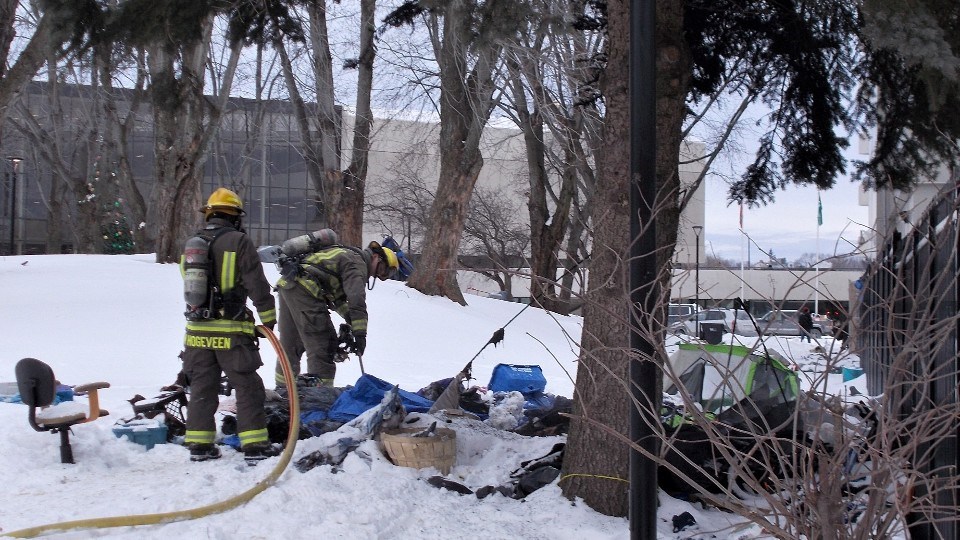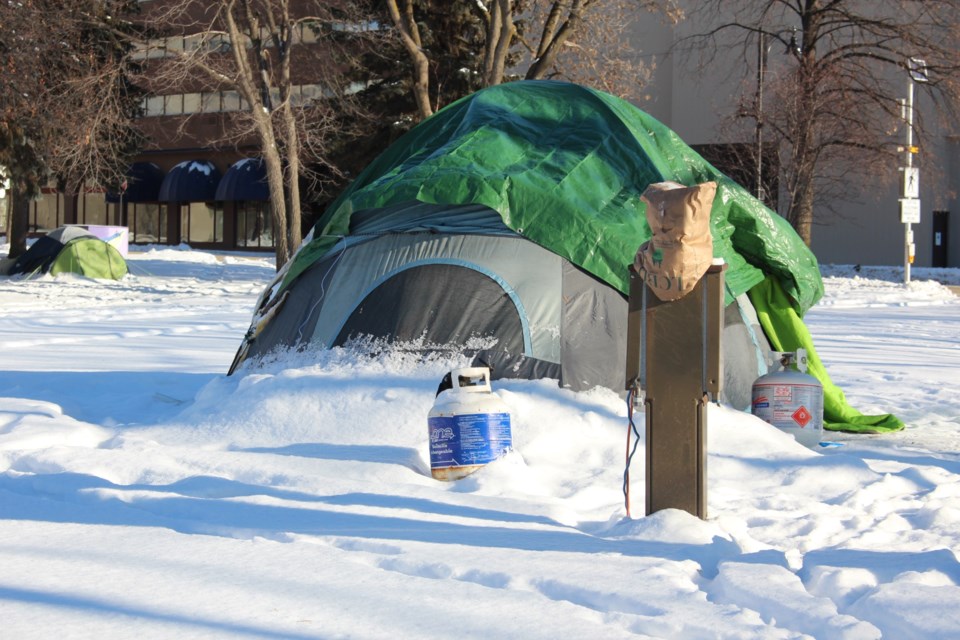A man who died in a fire at a homeless encampment Dec. 3 was warming himself with an open flame inside a tent, Greater Sudbury Fire Services told Sudbury.com.
“It’s a sad story related to an individual who was attempting to keep warm,” said Deputy Chief Jesse Oshell.
“I do know that we had responded to that area in the past and spoken to that particular individual, not formally or officially, but certainly they were known to many in the area and had chosen to be there.”
The death occurred just before 12 p.m., said GSPS spokesperson Kaitlyn Dunn.
“Officers were dispatched to a wooded area near North Field Crescent in relation to a sudden death. Greater Sudbury Fire Services responded to a fire in the bush at what was described as an encampment. Upon extinguishing the fire, firefighters located a deceased person,” she said. “No foul play is suspected and the incident did/does not appear to be suspicious in nature.”
Oshell said that over the last few years, and certainly since the beginning of the pandemic, the number of encampment fires is on the rise, mostly due to the numbers of people who are living outside in harsh conditions.
“We are seeing an increase of individuals choosing, or due to circumstance, being in those types of situations,” he said, referring to homeless encampments and ad-hoc structures.
He said firefighters are “becoming accustomed” to these situations and know to contact community partners.
“We are working very hard to do that education and messaging around fire safety and suppression, and we also then reach out to our community partners and to the City of Greater Sudbury resources so they know that there are options for them, and there's help available.”

As co-ordinator of housing services with the Centre de santé communautaire du Grand Sudbury, which runs the Homelessness Network, Raymond Landry spoke to the work of the “red coats” who perform the outreach work of which Oshell speaks.
The homelessness network is also tasked with extra levels of care during harsh winter weather conditions.
“At the start of the season, we discourage any use of additional heating items, such as anything that is lit on fire, or gasses, and to mitigate the cold, we're always offering additional blankets, sleeping bags, and when we have them, mattresses that are resistant to… wet situations,” said Landry. “On a daily basis, we provide dry warm clothes and undergarments.”
He said the other part of the strategy is to encourage shelter use, and if a cold alert is called, using the additional warming spaces that become available. The Homelessness Network will also drive individuals to the warming centres and shelters.
These additional spaces are open to anyone who is without a way to stay warm during extreme winter weather, including those who are housed, but without a heat source. These spaces — 25 at the Samaritan Centre, 30 at Grace United Church — were at a premium on Jan. 9 when a winter storm dropped several inches of snow during a blizzard. That night, Landry said spaces were at or over capacity.
These spaces are in addition to the city’s 77 overnight shelter beds. These beds are not available to all however: some are for men or women and gender diverse people, some are referral only, and some are only for youth.
Sacha Novak of the city communications department, told Sudbury.com the entire shelter system was at capacity for four nights during the month of December, 18 nights during the month of November, and 10 nights during the month of October.
During this time, there was an average of four out of 77 beds available, each at a different facility (and therefore, not open to all). Each shelter was either at capacity or had one or two beds available.
It was a similar story in late October, when Sudbury.com wrote of the shelters being at or near capacity for the previous 12 weeks. So much so that a man was taken to hospital in the early morning hours on Oct. 23 with symptoms of hypothermia and exposure after he fell asleep outside the at-capacity Off The Street shelter at 200 Larch Street.
It was an issue in October of 2022 as well.
The by-name list, maintained by the city, shows the number of people in Sudbury facing chronic homelessness who wish to have their name added to a housing list. As of Jan. 9, there were 232 actively homeless individuals on the list. Of those 232 people, 52 were staying in encampments, 55 were unsheltered, 79 were staying in shelters, and 46 were provisionally accommodated or 'unknown.'

In May of this year, there were 190 actively homeless individuals on the list.
“That's a pretty big number that continues to just creep up every month,” said Gail Spencer, city manager of housing stability and homelessness, at the time. She told Sudbury.com the high cost of living means new evictions, as well as difficulty housing those already on the by-name list.
Six months later, by Oct. 26, the number of actively homeless was at 240.
In October, 2022, there were 178 actively homeless individuals on the list.
And while the list does change, the number of homeless people remains somewhat static.
Ali Farooq of the mobile outreach Go-Give Project told Sudbury.com that with shelters commonly at or close to capacity, and no housing, it can come down to a choice between “burning to death or freezing to death.”
Farooq says the encampments are spread over the city, which makes it challenging to serve the encampments. “If something were to happen, it will be sometime before someone can be reached for help.”
He said he appreciates the education offered by the city to those at risk, but said that while most of the people the Go-Give Project serves understand the risk of fire, “if you're in blizzard or it's -25 outside, and opening up the tent is not an option because you're barely keeping warm, the wind is blowing through and all you have is a candle or an open flame to keep you warm, there doesn’t feel like much choice.”
Farooq said the decision comes down to pros and cons. “The pros are staying warm and potentially burning to death, versus not being warm and freezing.”
Farooq said many people they serve have lost fingers and toes to frostbite, and it even happens to those who are cognitively able to help themselves. For some, addictions prevent them from understanding the risk they are facing.
Farooq said people in encampments often use candles, but also burn alcohol swabs or hand sanitizer for warmth. Carbon monoxide poisoning becomes an issue when using fuels like propane.
He told Sudbury.com that while there are shelter spaces, there are also obstacles to using them. When there is vacancy, there is limited space for any belongings, which often double in size during the winter months. They also have to carry those belongings with them all day, as they wait to get back into the shelter.
“And some individuals have been banned from the services, or have temporary restrictions from services,” he said. “So they cannot go there even if they did want to.”
Landry said many are discouraged to even try because they are aware of the lack of space.
He said the city needs low-barrier warming spaces available every night, not just when an alert is triggered.
However, many problems arise from setting up a space, said Landry. He said the ability to staff them is an issue, with shortages across the social services sector, but the other issue is Insurance.
“This is typical across the country. Insurance companies are now blocking agencies from providing additional services, such as warming centers in non-typical spaces.”
Not only the risk of liability, said Landry, but because of the sheer number of programs needed, the insurance industry is backing away completely.
“When people say ‘just do this’ or ‘why don't you just do that?’ Well, there's a lot in the way of getting things done simply.”
Despite the challenges, Landry said he hopes funding from upper levels of government will help with more warming spaces during the cold winter months. He also hopes there will be a change in the one area that could affect homelessness: affordable housing.
Jenny Lamothe covers vulnerable and marginalized communities for Sudbury.com.
